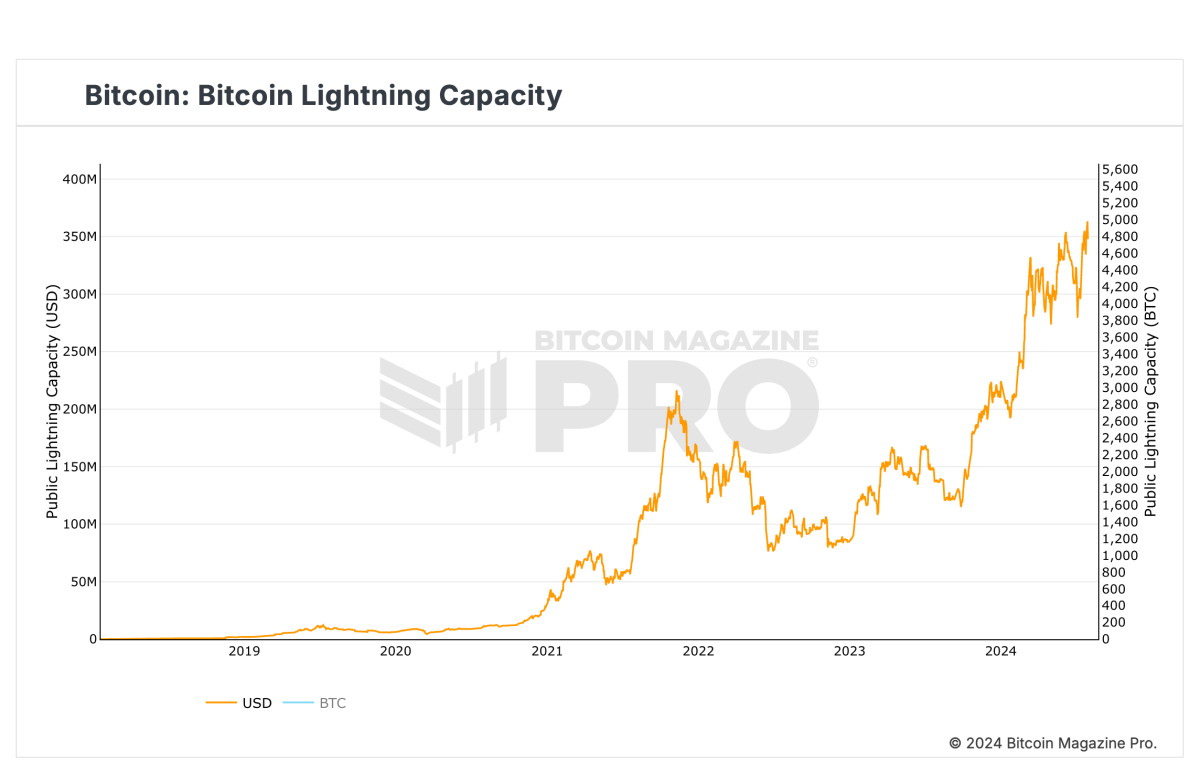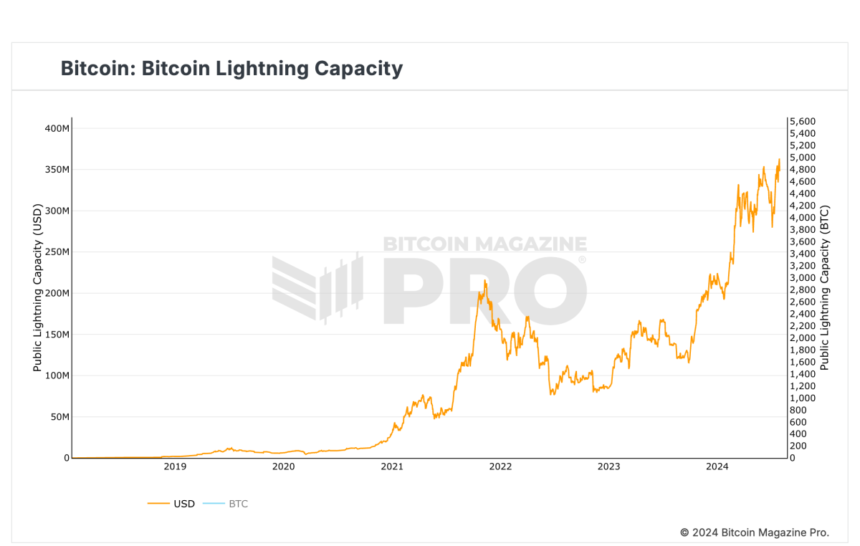During this year’s Bitcoin 2024 conference, I was asked multiple times what the highlight of the moment was — what was the signal amid the noise? And each time, upon returning from Nashville, I realized I couldn’t give a satisfactory answer to that question.
For one, I simply couldn’t keep up. The activity around the news desk and supporting the people running the show left little time to focus on anything else. I have no regrets; anyone who was in the livestream studio space that week can attest to the energy around it. The Bitcoin Magazine news desk was truly the heartbeat of the conference.
Now that I’ve had time to gather my thoughts, I can confidently say that the most noticeable thing at the conference was the understated presence of the Lightning Network. At another time, this would have been a concern, but this time it felt different. I got the impression that Lightning had not only arrived, but was mature beyond what any other scaling layer could realistically claim.
Almost unnoticed, the payment protocol has been quietly integrated into every part of the core Bitcoin infrastructure. Most of the world’s major exchanges now support it, and some of them run the largest nodes on the network. The network’s dollar-denominated capacity has reached an all-time high, and every operator I spoke to this week confirmed that its reliability is rapidly improving.

To the general conference attendees, it may have seemed like Lightning was lagging behind other emerging protocols, but it was clear throughout the conference that Lightning is far ahead of the rest of the field. I was fortunate to meet many of the talented people working on this new generation of Bitcoin technology design, and I left the event with more questions about their progress than I had when I entered. Lightning, on the other hand, answered many of my concerns about its current state and its path forward.
View of the village
One theme that was repeated throughout the event was the protocol’s promise as a payments network. Initially touted as a retail payments solution, Lightning’s latest and greatest advances may be happening among businesses and institutions looking to fill their liquidity needs. This vision, notably popularized by Strike’s Jack Mallers, is more concrete than ever, with infrastructure company Lightspark now at the forefront of these achievements. Last Thursday, On the Nakamoto Stage, Light Spark Co-founder Christian Catalini argued that Lightning is well-positioned to act as a bridge between businesses and various financial institutions.
Consider the challenge of moving value not just between a few countries, but over 200 countries, 24/7/365 with high liquidity. There is only one asset, and that asset is Bitcoin. The regulations are clear, and on-ramps and off-ramps exist in almost every country around the world. Now we can connect everything in an open way.
Light Spark Recent Announcements Partnership with major Latin American banks Nubank It clearly demonstrates the potential for incumbents to use the Lightning Network to modernize their infrastructure.
Last week further strengthened the case that Lightning is the railroad that connects the global economy. release Lightning Labs’ Taproot Asset protocol brings new opportunities for the scaling layer to establish itself as the leading value transfer protocol on the Internet. Before Lightning can be deployed to VISA, it may first need to replace SWIFT.
Payment Improvements
On the payments side, the talk of Nashville was about improved user experience brought about by the introduction of features such as: Bolt 12.
This payments protocol, which has been in development for years, provides an intuitive way for users to receive Lightning payments without relying on unreliable out-of-date invoices. It also paves the way for improving users’ ability to receive payments offline, a major pain point in current implementations.
Introduction #12 CacheAn easy way to share your Bitcoin payment information with the world. pic.twitter.com/tynzAVEEEt
— Stephen DeLorme (@StephenDeLorme) July 18, 2024
BOLT12 achieves this through static, reusable offers that do not violate recipient privacy. DNS Payment Instructionsyou can now create human-readable Bitcoin addresses (e.g. alex@twelve.cash) that support a variety of payment formats. Imagine receiving on-chain and Lightning payments using a single identifier, regardless of your preferred standard. 12. Cachea standout project at this year’s conference. Hackathonhas done a great job of highlighting the versatility of this technology and implementing “a simple way to share Bitcoin payment information with the world.”
Other forms of human-readable addresses using the LNURL format have existed for some time, but the hope is that users will converge to a more mature solution. Longtime Lightning infrastructure provider Amboss is also Announced The event unveiled a new Lightning wallet that supports a novel multi-asset payment system called “MIBAN.”
In an open, permissionless financial system, fragmentation and compatibility issues between standards are to be expected, and Lightning stands out above all other options in optimizing for these interoperability challenges to ensure a seamless payments experience.
BOLT12 is currently supported by major wallets such as Phoenix and ZEUS. Can land It will be available soon on the Strike app.
I remember being pretty disillusioned about the prospects for public Lightning apps after attending Bitcoin Park’s Lightning Summit around this time last year. Things have changed a lot in a year. While a fully unmanaged experience may always command a premium price, new optimizations and different security models are emerging that cater to the retail user landscape.
Large-Scale Infrastructure
This progress at all levels would not have been possible without the tremendous efforts made over the past few years to improve infrastructure.
Lightspark, which supports Lightning integrations from other industry giants such as Coinbase and Bitso, is Spiral’s Lightning Developer Kit (LDK). Recently Announced Alby Hub is LDK Node library.
Keep in mind that LDK has been in development for nearly four years already – good things take time, and many people who spoke during the conference expect to see a significant acceleration in the scope and quality of projects deployed using this toolkit.
Another sign of the evolution of lightning infrastructure is release This week saw the launch of Breez LDK’s new Liquid integration. This is a trend that is gaining momentum and was pioneered by BoltzA swapping service for Bitcoin, used by wallet applications. AquaLiquid allows developers to take advantage of the sidechain network’s cheaper fees to settle transactions from Lightning to L-BTC, and while this comes with a custody trade-off, proponents argue this is a better option than fully custodial Lightning wallets.
The conference also highlighted progress at the Lightning Service Provider (LSP) specification level, resulting in a significant improvement in the quality of service providers on the network. LSPs are used to provide infrastructure support and liquidity to businesses wanting to connect to the Lightning Network.
Zeus founder Evan Kaloudis spoke about his company’s efforts in this direction:
Since the arrest of the Samourai Wallet developers has created legal uncertainty in this area, we have doubled down and now have two different services offering users connectivity to the Lightning Network. We have also significantly expanded our Olympus LSP user base, and now not only support ZEUS wallet but are integrated into a total of four different wallets, including serving as the default LSP for Mutiny Wallet.
Security is another area where the protocol is seeing significant growth. Spiral Grant Recipient Sean GillianWork of Lightning Signer Verification (VLS) will play a key role in scaling this technology to power users, and allowing operators to leverage secure enclaves to protect hot signing keys and set spending policies will be necessary to get the next wave of institutional investors on board.
At a panel I hosted on Saturday afternoon about Lightning for Institutions, Tadge Dryja, one of the protocol’s creators, expressed a strong interest in developing more secure key management processes.
We’ve figured out how to implement multi-signature support in Lightning Node, we’ve done the math, and we know it works — now we all need to work together to get there.
It wouldn’t be an infrastructure section without mentioning the major innovation in the Nostr protocol and how it will impact Lightning. Pitch Day The project at the meeting flashis a new payment gateway platform that leverages Nostr to seamlessly integrate Lightning into any Internet service or product. The ramifications of using the Nostr messaging protocol as a bridge between Bitcoin applications are yet to be fully understood. The Flash team A great vision Thank you. And thanks to Justin. Shock Net I met him and he is exploring a lot of interesting ways to extend the Lightning protocol using Nostr’s magic sauce.
It’s time to stop the fading Lightning.






